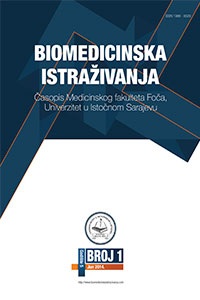Effect of using HEART score in patients with chest pain at the emergency department of University Clinical Centre of the Republic of Srpska
DOI:
https://doi.org/10.5937/BII2101001SAbstract
Introduction. Recent data show that 1/5 of patients with chest
pain in emergency room (ER) have an acute coronary syndrome
that requires admission and treatment. Current guidelines have
endorsed the HEART score for admission, observation or discharge
in individual patients. We aimed to assess performance of
the HEART score at the University Clinical Centre of the Republic
of Srpska.
Methods. Between March 1 and March 31, 2019, all patients with
chest pain who presented at ER were evaluated. The HEART score
for each patient was calculated, and patients were stratified based
on the HEART score recommendation, i.e. low-, intermediate- and
high-risk. Patients were followed 6 weeks for major adverse cardiac
events (MACE).
Results. Out of a total of 144 included patients, 23 had low-risk
(0−3) HEART scores, while 73 and 48 patients had intermediate-risk
(4−6) and high-risk (7−10) HEART scores, respectively. The discordance
among intuitive judgments by clinicians and the HEART
score advice became typically obtrusive in patients with excessive
(7−10) HEART score rankings: 25 out of 48 (52.1%) patients
had been discharged, while the remaining 22 patients had been
admitted and 1 person was observed. In population with HEART
score rankings 4–6, MACE became recognized in 1/73 (1.4%) while
in patients with excessive HEART score rankings (values 7–10),
MACE befell in 5/48 (10.4%). Only one patient who was discharged
experienced MACE. The ROC analysis of the HEART score revealed
a value of 0.78, suggesting a good performance in discriminating
between low- and high-risk patients.
Conclusion. Discordance between clinical decision and HEART
score recommendation was not associated with severe clinical
consequences.

